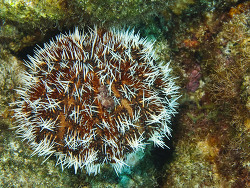Info
Tripneustes ventricosus
They are common in the Caribbean, Bahamas, and Florida, and may be found at depths of 0 to 10 metres.
The West Indian sea egg feeds on algae but tends to avoid the crustose, highly calcified coralline algae
Synonyms:
Echinus ventricosus Lamarck, 1816
Heliechinus gouldii Girard, 1850 )
Hipponoe esculenta A. Agassiz, 1872
Tripneustes esculenta (A. Agassiz, 1872)
Tripneustes esculentus (A. Agassiz, 1872)
They are common in the Caribbean, Bahamas, and Florida, and may be found at depths of 0 to 10 metres.
The West Indian sea egg feeds on algae but tends to avoid the crustose, highly calcified coralline algae
Synonyms:
Echinus ventricosus Lamarck, 1816
Heliechinus gouldii Girard, 1850 )
Hipponoe esculenta A. Agassiz, 1872
Tripneustes esculenta (A. Agassiz, 1872)
Tripneustes esculentus (A. Agassiz, 1872)







 Dr. Paddy Ryan, USA
Dr. Paddy Ryan, USA








